Northern Virginia
Northern Virginia, locally referred to as NOVA or NoVA, comprises several counties and independent cities in the Commonwealth of Virginia in the United States. It is a widespread region radiating westward and southward from Washington, D.C. With an estimated 3,159,639 residents in 2019 (37.02 percent of Virginia's total population), it is the most populous region of Virginia and the Washington metropolitan area.[2][3][4]
Northern Virginia | |
|---|---|
Region | |
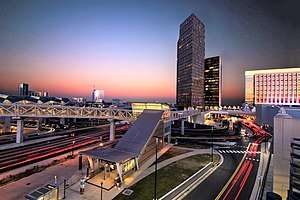 Tysons in Fairfax County | |
| Nickname(s): NOVA, NoVA, Nova | |
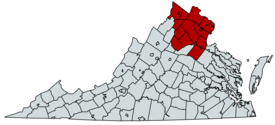 The counties of Virginia that form part of the Washington-Baltimore Combined Statistical Area. | |
| Country | |
| State | |
| Counties and Independent Cities | Alexandria city, Arlington County, Clarke County, Culpeper County, Fairfax city, Fairfax County, Falls Church city, Fauquier County, Frederick County, Fredericksburg city, Loudoun County, Madison County, Manassas city, Manassas Park city, Prince William County, Rappahannock County, Spotsylvania County, Stafford County, Warren County, Winchester city |
| Largest city | Alexandria |
| Area | |
| • Land | 11,425.6 km2 (4,411.45 sq mi) |
| 13 counties and 7 independent cities in Virginia within the Washington Metropolitan Statistical Area or Washington-Baltimore Combined Statistical Area | |
| Population (2019) | 3,159,639 |
| • Density | 276.54/km2 (716.24/sq mi) |
| Demonym(s) | Northern Virginian |
Communities in the region form the Virginia portion of the Washington metropolitan area and the larger Baltimore–Washington metropolitan area. Northern Virginia has a significantly larger job base than either Washington or the Maryland portion of its suburbs,[5] and is the highest-income region of Virginia, having several of the highest-income counties in the nation.[6]
Northern Virginia's transportation infrastructure includes major airports Ronald Reagan Washington National and Washington Dulles International, several lines of the Washington Metro subway system, the Virginia Railway Express suburban commuter rail system, transit bus services, bicycle sharing and bicycle lanes and trails, and an extensive network of Interstate highways and expressways.
Notable features of the region include the Pentagon and the Central Intelligence Agency, and the many companies which serve them and the U.S. federal government. The area's attractions include various monuments and Colonial and Civil War–era sites such as Mount Vernon and Arlington National Cemetery.
Etymology
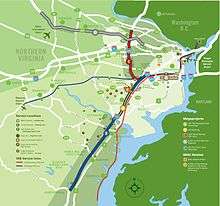
The region is often spelled "northern Virginia", although according to the USGS Correspondence Handbook the 'n' in Northern Virginia should be capitalized since it is a place name rather than a direction or general area; e.g. Eastern United States vs. western Massachusetts.[7]
The name "Northern Virginia" does not seem to have been used in the early history of the area.[8] According to Johnston, some early documents and land grants refer to the "Northern Neck of Virginia" (see Northern Neck Proprietary), and they describe an area which began on the east at the western shore of the Chesapeake Bay and includes a territory that extended west, including all the land between the Potomac and Rappahannock rivers, with a western boundary called the Fairfax line.[8] The Fairfax line, surveyed in 1746, ran from the first spring of the Potomac (still marked today by the Fairfax Stone) to the first spring of the Rappahannock, at the head of the Conway River.[8] The Northern Neck was composed of 5,282,000 acres (21,380 km2), and was larger in area than five of the modern U.S. states.[8]
This monument, at the headspring of the Potomac River, marks one of the historic spots of America. Its name is derived from Thomas Lord Fairfax who owned all the land lying between the Potomac and Rappahannock Rivers. The first Fairfax Stone, marked "FX", was set in 1746 by Thomas Lewis, a surveyor employed by Lord Fairfax. This is the base point for the western dividing line between Maryland and West Virginia.
— Fairfax Stone inscription[8]
Early development of the northern portion of Virginia was in the easternmost area of that early land grant, which encompasses the modern counties of Lancaster, Northumberland, Richmond, and Westmoreland. At some point, these eastern counties came to be called separately simply "the Northern Neck", and, for the remaining area west of them, the term was no longer used. (By some definitions, King George County is also included in the Northern Neck, which is now considered a separate region from Northern Virginia.[9])
One of the most prominent early mentions of "Northern Virginia" (sans the word Neck) as a title was the naming of the Confederate Army of Northern Virginia during the American Civil War (1861–1865).
Definition
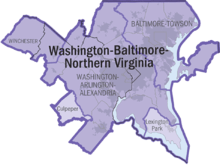
The most common definition of Northern Virginia includes the independent cities and counties on the Virginia side of the Washington-Baltimore-Arlington, DC-MD-VA-WV-PA Combined Statistical Area as defined by the U.S. Office of Management and Budget[10] within the Executive Office of the President of the United States.
Most narrowly defined, Northern Virginia consists of the counties of Arlington, Fairfax, Loudoun, Prince William, and Stafford as well as the independent cities of Alexandria, Fairfax, Falls Church, Manassas, and Manassas Park.
Businesses, governments and non-profit agencies may define the area considered "Northern Virginia" differently for various purposes. Many communities beyond the areas closest to Washington, DC also have close economic ties, as well as important functional ones, to Northern Virginia, especially regarding roads, railroads, airports, and other transportation.
History
Colonial period
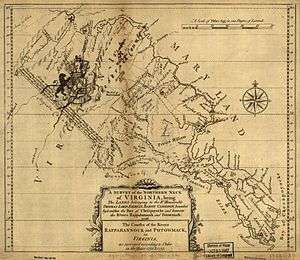
Historically, in the British Colony of Virginia first permanently settled at Jamestown in 1607, the area now generally regarded as "Northern Virginia" was within a larger area defined by a land grant from King Charles II of England on September 18, 1649, while the monarch was in exile in France during the English Civil War. Eight of his loyal supporters were named, among them Thomas Culpeper.[11]
On February 25, 1673, a new charter was given to Thomas Lord Culpeper and Henry Earl of Arlington. Lord Culpeper was named the Royal Governor of Virginia from 1677–1683. Culpeper County was later named for him when it was formed in 1749; however, history does not seem to record him as one of the better of Virginia's colonial governors. Although he became governor of Virginia in July 1677,[12] he did not come to Virginia until 1679, and even then seemed more interested in maintaining his land in the "Northern Neck of Virginia" than governing. He soon returned to England.[13] In 1682 rioting in the colony forced him to return, but by the time he arrived, the riots were already quelled. After apparently misappropriating £9,500 from the treasury of the colony, he returned to England and the King was forced to dismiss him. During this tumultuous time, Culpeper's erratic behavior meant that he had to rely increasingly on his cousin and Virginia agent, Col. Nicholas Spencer.[14][15] Spencer succeeded Culpeper as acting Governor upon Lord Culpeper's departure from the colony. For many years, Lord Culpeper's descendants allowed men in Virginia (primarily Robert "King" Carter) to manage the properties.[16]
Legal claim to the land was finally established by Lord Culpeper's grandson, Thomas Fairfax, 6th Lord Fairfax of Cameron, who became well known in the colony as "Lord Fairfax", in a survey authorized by Governor William Gooch in 1736. The lands of Lord Fairfax (and Northern Virginia) were defined as that between the Rappahannock and Potomac rivers, and were officially called the "Northern Neck".[17] In 1746 a back line was surveyed and established between the headwaters of the Potomac and Rappahannock rivers, defining the west end of the grants. According to documents held by the Handley Regional Library of the Winchester–Frederick County Historical Society, the grants contained 5,282,000 acres (21,380 km2). They included the 22 modern counties of Northumberland, Lancaster, Westmoreland, Stafford, King George, Prince William, Fairfax, Loudoun, Fauquier, Rappahannock, Culpeper, Madison, Clarke, Warren, Page, Shenandoah, and Frederick counties in Virginia, and Hardy, Hampshire, Morgan, Berkeley, and Jefferson counties in West Virginia.[18]
Lord Fairfax was a lifelong bachelor, and became one of the more well-known persons of the late colonial era. In 1742 the new county formed from Prince William County was named Fairfax County in his honor, one of numerous place names in Northern Virginia and West Virginia's Eastern Panhandle which were named after him.[19] Lord Fairfax established his residence first at his brother's home at "Belvoir" (now on the grounds of Fort Belvoir in Fairfax County).[16]
Not long thereafter, he built a hunting lodge near the Blue Ridge Mountains he named "Greenway Court",[11] which was located near White Post in Clarke County, and moved there. Around 1748 Lord Fairfax met a youth of 16 named George Washington, and, impressed with his energy and talents, employed him to survey his lands lying west of the Blue Ridge.[11]
Lord Fairfax stayed neutral during the American Revolutionary War. Just a few weeks after the surrender of British troops under General Cornwallis at Yorktown, he died at his home at Greenway Court on December 9, 1781, at the age of 90. He was entombed on the east side of Christ Church in Winchester.[16] While his plans for a large house at Greenway Court never materialized, and his stone lodge is now gone, a small limestone structure he had built still exists on the site.[11]
Statehood, Civil War
Following the American Revolutionary War, when the thirteen colonies formed the United States of America, war hero and Virginian George Washington was the choice to become its first president. Washington had been a surveyor and developer of canals for transportation earlier in the 18th century. He was also a great proponent of the bustling port city of Alexandria, which was located on the Potomac River below the fall line, not far from his plantation at Mount Vernon in Fairfax County.
With his guidance, a new federal city (now known as the District of Columbia) was laid out straddling the Potomac River upon a square of territory which was ceded to the federal government by the new states of Maryland and Virginia. Alexandria was located at the eastern edge south of the river. On the outskirts on the northern side of the river, another port city, Georgetown, was located.
However, as the federal city grew, land in the portion contributed by Maryland proved best suited and adequate for early development, and the impracticality of being on both sides of the Potomac River became clearer. Not really part of the functioning federal city, many citizens of Alexandria were frustrated by the laws of the District government and lack of voting input. Slavery also arose as an issue. To mitigate these issues, and as part of a "deal" regarding abolishment of slave trading in the District, in 1846, the U.S. Congress passed a bill retroceding to Virginia the area south of the Potomac River, which was known as Alexandria County. That area now forms all of Arlington County (which was renamed from Alexandria County in 1922) and a portion of the independent city of Alexandria.
Slavery, states' rights, and economic issues increasingly divided the northern and southern states during the first half of the 19th century, eventually leading to the American Civil War from 1861 to 1865. Although Maryland was a slave state, it remained with the Union, while Virginia seceded and joined the newly formed Confederate States of America, with its new capital established at Richmond.
The Supreme Court of the United States has never issued a firm opinion on whether the retrocession of the Virginia portion of the District of Columbia was constitutional. In the 1875 case of Phillips v. Payne, the Supreme Court held that Virginia had de facto jurisdiction over the area returned by Congress in 1847, and dismissed the tax case brought by the plaintiff. The court, however, did not rule on the core constitutional matter of the retrocession. Writing the majority opinion, Justice Noah Swayne stated only that:
The plaintiff in error is estopped from raising the point which he seeks to have decided. He cannot, under the circumstances, vicariously raise a question, nor force upon the parties to the compact an issue which neither of them desires to make.[20]
With barely 100 miles (160 km) separating the two capital cities, Northern Virginia found itself in the center of much of the conflict. The area was the site of many battles and saw great destruction and bloodshed. The Army of Northern Virginia was the primary army for the Confederate States of America in the east. Owing to the region's proximity to Washington, D.C., and the Potomac River, the armies of both sides frequently occupied and traversed Northern Virginia. As a result, several battles were fought in the area.
In addition, Northern Virginia was the operating area of the famed Confederate partisan, John Singleton Mosby, and several small skirmishes were fought throughout the region between his Rangers and Federal forces occupying Northern Virginia.
Well after the war, the conflict remained popular among the region's residents, and many area schools, roads, and parks were named for Confederate generals and statesmen, for example Jefferson Davis Highway and Washington-Lee High School.
Virginia split during the American Civil War, as was foreshadowed by the April 17, 1861, Virginia Secession Convention. Fifty counties in the western, mountainous, portion of the state, who were, for the most part, against secession in 1861, would break away from the Confederacy in 1863 and enter the Union as a new state, West Virginia. Unlike the eastern part of the state, West Virginia did not have fertile lands tilled by slaves and was geographically separated from the state government in Richmond by the Appalachian Mountains. During this process, a provisional government of Virginia was headquartered in Alexandria, which was under Union control during the war.[21] Notably, Arlington, Clarke, Fairfax, Frederick, Loudoun, Shenandoah, and Warren Counties voted in favor of Virginia remaining in the Union in 1861 but did not eventually break away from the state.[22]
As a result of the formation of West Virginia, part of Lord Fairfax's colonial land grant which defined Northern Virginia was ceded in the establishment of that state in 1863. Now known as the Eastern Panhandle of West Virginia, the area includes Berkeley County and Jefferson County, West Virginia.
20th century and beyond
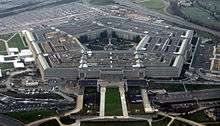
The Department of Defense's increasing reliance on information technology companies during the Cold War started the modern Northern Virginia economy and spurred urban development throughout the region.[23] After the Cold War, prosperity continued to come as the region positioned itself as the "Silicon Valley" of the Eastern United States. The Internet was first commercialized in Northern Virginia, having been home to the first Internet service providers.[24]
The first major interconnection point of the Internet, MAE-East, was established in the 1990s at Ashburn after Virginia-area network provider operators thought to connect their networks together while drinking beer.[25] This infrastructure legacy is ongoing, as data center operators continue to expand near these facilities.[26][27]
History was made in early 2001 when local Internet company America Online bought Time Warner, the world's largest traditional media company, near the end of the dot-com bubble days. After the bubble burst, Northern Virginia office vacancy rates went from 2 percent in 2000 to 20 percent in 2002.[23] After 2002, vacancy rates fell below 10 percent due to increased defense spending after the September 11 attacks, and the Afghanistan and Iraq wars causing the government's continued and increasing reliance on private defense contractors.[23]
Regional organizations
Northern Virginia Regional Commission
Northern Virginia is an area within the Commonwealth of Virginia and is part of the Washington DC metropolitan area. The Northern Virginia Regional Commission[28](NVRC) is a regional government that represents a regional council of thirteen member Northern Virginia local governments.[29] These local governments include the counties of Arlington, Fairfax, Loudoun, and Prince William. The local governments include the incorporated cities of Alexandria, Fairfax, Falls Church, Manassas, and Manassas Park. The local governments also include the incorporated towns of Dumfries, Herndon, Leesburg, and Vienna. NVRC’s chief roles and functions have focused on providing information, performing professional and technical services for its members, and serving as a mechanism for regional coordination regarding the environment, transportation, affordable housing, community planning, military, and human services. Programs and projects address a wide array of local government interests.
According to Virginia’s Regional Cooperation Act, NVRC is a political subdivision (a government agency) within the Commonwealth. The region is technically referred to as Virginia’s planning district #8.[30] The Commission was established pursuant to Articles 1 and 2, Chapter 34, of the Acts of the Virginia General Assembly of 1968, subsequently revised and re-enacted as the Regional Cooperation Act under Title 15.2, Chapter 42 of the Code of Virginia, hereinafter called the "Act", and by resolutions of the governing bodies of its constituent member governmental subdivision. Any incorporated county, city or town in Northern Virginia may become a member of NVRC, provided the jurisdiction has a population of more than 3,500 and adopts and executes NVRC’s Charter Agreement.
Metropolitan Washington Council of Governments
Northern Virginia constitutes a considerable portion of the population and number of jurisdictions that comprise the Metropolitan Washington Council of Governments (MWCOG). Founded in 1957, MWCOG is a regional organization of 22 Washington-area local governments, as well as area members of the Maryland and Virginia state legislatures, the U.S. Senate, and the U.S. House of Representatives. MWCOG provides a forum for discussion and the development of regional responses to issues regarding the environment, transportation, public safety, homeland security, affordable housing, community planning, and economic development.[31]
The National Capital Region Transportation Planning Board, a component of MWCOG, is the federally designated metropolitan planning organization for the metropolitan Washington area, including Northern Virginia.[32]
Demographics
| Historical population | |||
|---|---|---|---|
| Census | Pop. | %± | |
| 1900 | 188,919 | — | |
| 1910 | 194,731 | 3.1% | |
| 1920 | 206,504 | 6.0% | |
| 1930 | 229,205 | 11.0% | |
| 1940 | 298,588 | 30.3% | |
| 1950 | 488,945 | 63.8% | |
| 1960 | 788,162 | 61.2% | |
| 1970 | 1,118,064 | 41.9% | |
| 1980 | 1,357,387 | 21.4% | |
| 1990 | 1,805,091 | 33.0% | |
| 2000 | 2,253,251 | 24.8% | |
| 2010 | 2,794,957 | 24.0% | |
| Est. 2019 | 3,159,639 | 13.0% | |
| 1910–2010[33] 2017 estimate[34] | |||
As of July 2019 there were 3,159,639 people in Northern Virginia; approximately 37 percent of the state's population.[35]
These population counts include all counties within Virginia that are part of the Washington-Arlington-Alexandria, DC-VA-MD-WV Metropolitan Statistical Area or the Washington-Baltimore-Arlington, DC-MD-VA-WV-PA Combined Statistical Area as defined by the U.S. Office of Management and Budget[10] within the Executive Office of the President of the United States.
Of the 3,159,639 people in Northern Virginia in the 2019 estimates, 2,748,978 lived in "central" counties, or those counties and equivalent entities as delineated by the U.S. Office of Management and Budget as forming part of the urban core of the Washington Metropolitan Statistical Area. These counties include Arlington, Fairfax, Fauquier, Loudoun, Prince William, Stafford and the independent cities of Alexandria, Fairfax, Falls Church, Manassas, and Manassas Park.
An additional 410,661 people lived in counties of the Washington Metropolitan Statistical Area or the Baltimore-Washington Combined Statistical Area not considered "central." These counties, largely considered exurban or undergoing suburban change, include Clarke, Culpeper, Frederick, Madison, Rappahannock, Spotsylvania, Warren, and the independent cities of Fredericksburg and Winchester.
In addition, there are counties outside of the Washington Metropolitan Area that under more broad definitions are referred to as being part of Northern Virginia. The University of Virginia Weldon Cooper Center for Public Service categorizes King George County as part of Northern Virginia, though the county was removed from the Washington Metropolitan Area in 2003.[36] King George County and Orange County also include areas, such as Lake of the Woods, where the cross-commuting interchange with the Washington Metropolitan Area is high enough to merit inclusion in the Metropolitan Area,[37] although more far-flung parts of these counties still cause the county-wide commuter interchange to fall below the threshold for inclusion in the Washington Metropolitan Area or Washington-Baltimore Combined Statistical Area. The demographic figures above do not include population counts for these two counties.
Racial and ethnic composition
The 2010 U.S. Census shows that the racial and ethnic makeup of the 2,230,623 people that reside in the counties of Arlington, Fairfax, Loudoun, and Prince William as well as the cities of Alexandria, Falls Church, Fairfax, Manassas, and Manassas Park are as follows:
- 55.41% White
- 11.28% Black
- 10.46% Asian
- 0.19% American Indian or Alaska native
- 0.07% Native Hawaiian and Other Pacific Islander
- 0.30% Some other race
- 2.98% Two or more races
- 16.30% Hispanic and/or Latino (of any race)
Background
| Demographics in Northern Virginia's five largest jurisdictions[4] | |||
|---|---|---|---|
| Household income | No. VA | U.S. | |
| ($200k+) | 13.6% | 3.7% | |
| $100k+ | 46.1% | 19.0% | |
| $75k-100k | 15.1% | 12.1% | |
| $50k-75k | 16.3% | 18.8% | |
| $25k-50k | 14.2% | 25.6% | |
| $25k or less | 8.4% | 24.5% | |
| Race | No. VA | U.S. | |
| White | 67.2% | 74.1% | |
| Black or African American | 11.6% | 12.4% | |
| Asian | 12.5% | 4.3% | |
| (Hispanic or Latino) | 13.9% | N/A | |
| Some other race | N/A | 6.2% | |
| Two or more races | 2.4% | 2.1% | |
| Educational attainment | No. VA | U.S. | |
| (Graduate/professional) | 25.2% | 9.9% | |
| Bachelor's or higher | 55.5% | 27.0% | |
| Associate's | 5.7% | 7.4% | |
| Some college | 14.8% | 19.5% | |
| High school/equivalent | 15.8% | 30.2% | |
| Less than high school | 8.1% | 15.9% | |
Northern Virginia is home to people from diverse backgrounds, with significant numbers of Korean Americans, Vietnamese Americans, Bangladeshi Americans, Chinese Americans, Filipino Americans, Russian Americans, Arab Americans, Palestinian Americans, Uzbek Americans, Afghan Americans, Ethiopian Americans, Indian Americans, Iranian Americans, Thai Americans, and Pakistani Americans. Annandale, Chantilly, and Fairfax City have very large Korean American communities. Falls Church has a large Vietnamese American community. Northern Virginia is also home to a small Tibetan American community as well.
There is a sizable Hispanic population, primarily consisting of Salvadorans, Peruvians, Puerto Ricans, Cubans, Bolivians, Mexicans, and Colombians. Arlington is the center of the largest Bolivian community in North America (mostly immigrants from Cochabamba). Many of these immigrants work in transportation-related fields, small businesses, hospitality/restaurants, vending, gardening, construction, and cleaning.
Of those born in the U.S. and living in Northern Virginia's four largest counties, their place of birth by census region is 60.5 percent from the South, 21.0 percent from the Northeast, 11.5 percent from the Midwest, and 7.0 percent from the West. 33.7 percent were born in Virginia, which is categorized as part of the Southern United States along with neighboring Maryland and Washington, D.C., by the Census Bureau.[38][39][40][41]
Educational attainment
The core Northern Virginia jurisdictions of Alexandria, Arlington, Fairfax, Loudoun, and Prince William comprising a total population of 1,973,513 is highly educated, with 55.5 percent of its population 25 years or older holding a bachelor's degree or higher. This is comparable to Seattle, the most educated large city in the U.S., with 53.4 percent of residents having at least a bachelor's degree.[42][43] The number of graduate/professional degree holders in Arlington is relatively high at 34.3 percent, nearly quadruple the rate of the U.S. population as a whole.[44]
Affluence
The region is known in Virginia and the Washington, D.C., area for its relative affluence. Stafford one of the core counties in Northern Virginia is one of the seven counties in America where Black Households make more than White Households. Stafford County actually topped the list with African-Americans in Stafford County making the highest amount on the list.[45]. Of the large cities or counties in the nation that have a median household income in excess of $100,000, the top two are in Northern Virginia, and these counties have over half of the region's population.[46] However, considering that Northern Virginia has one of the highest costs of living in the nation, the actual purchasing power of these households is considerably less than in other less "affluent" areas.[47] According to Nielsen Claritas, Loudoun County and Arlington County have the highest concentration of 25- to 34-year-olds with incomes of $100,000+ in the nation.[48][49]
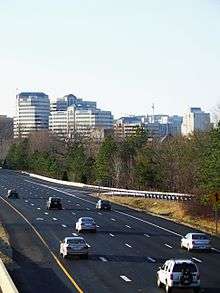
In 1988, the Tysons Galleria mall opened across Virginia Route 123 from Tysons Corner Center with high-end department stores Neiman Marcus and Saks 5th Avenue, hoping to become the Washington area's upscale shopping destination. The mall had trouble with sales and attracting high-end boutiques well into the 1990s and faced competition from Fairfax Square, which opened nearby in 1990 with the largest Tiffany & Co. boutique outside of New York City.[51] The Galleria was able to attract high-end stores after a 1997 renovation, and in 2002 National Geographic described it as "the Rodeo Drive of the East Coast."[52] In 2008 luxury home service Sotheby's International Realty – which had three offices in Virginia serving the rest of the state, and two in the District of Columbia serving the Washington metropolitan area – opened a new office in McLean to sell more high-end real estate in Northern Virginia.[53]
Crime
A 2009 report by the Northern Virginia Regional Gang Task Force suggests that anti-gang measures and crackdowns on illegal immigrants by local jurisdictions are driving gang members out of Northern Virginia and into more immigrant-friendly locales in Maryland, Washington, D.C., and the rest of Virginia.[54] The violent crime rate in Northern Virginia fell 17 percent from 2003 to 2008.[54] Fairfax County has the lowest crime rate in the Washington metropolitan area, and the lowest crime rate amongst the 50 largest jurisdictions of the United States.[55][56][57]
While the region has extremely low violent crime rates, it is an emerging hub for teen sex trafficking, with regional gangs finding it more profitable than selling drugs or weapons.[58]
Economy
.jpg)
Former Virginia Governor Bob McDonnell described Northern Virginia as "the economic engine of the state" during a January 2010 Northern Virginia Technology Council address.[61]
As of 2007 the Northern Virginia office submarkets contain 172,000,000 square feet (16,000,000 m2) of office space, 33 percent more than those in Washington, D.C., and 55 percent more than those in its Maryland suburbs. 8,000,000 square feet (740,000 m2) of office space is under construction in Northern Virginia. 60 percent of the construction is occurring in the Dulles Corridor submarket.[62]
In September 2008 the unemployment rate in Northern Virginia was 3.2 percent, about half the national average, and the lowest of any metropolitan area if ranked.[63][64] While the U.S. as a whole had negative job growth from September 2007 to September 2008, Northern Virginia gained 12,800 jobs, representing half of Virginia's new jobs.[65] As of July 2010 the unemployment rate of the region 5.2 percent, down from 5.3 percent in the previous month.[66] In the mid-2000s Fairfax County was one of few places in the nation that attracted more creative-class workers than it created.[67]
Internet
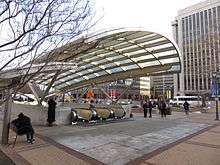
Northern Virginia is the busiest Internet intersection in the nation,[69] with up to 70 percent of all Internet traffic flowing through Loudoun County data centers every day.[27] It is the largest data center market in the world by capacity, with nearly double that of London, as well as the world's fastest growing market in 2018.[70][71] Loudoun County expects to have 6,500,000 square feet (600,000 m2) of data center space by 2021.[72] By 2012 Dominion Power expects that 10 percent of all electricity it sends to Northern Virginia will be used by the region's data centers alone.[73] Accenture estimates that 70 percent of Amazon Elastic Compute Cloud servers are located in their Northern Virginia zone.[74][75] A 2015–16 estimate by Greenpeace puts Amazon's current and upcoming power capacity in Northern Virginia at over 1 gigawatt.[69]
Federal government

The federal government is a major employer in Northern Virginia, which is home to numerous government agencies; these include the Central Intelligence Agency headquarters and the Pentagon (headquarters of the Department of Defense), as well as Fort Myer, Fort Belvoir, Marine Corps Base Quantico, FBI Academy, DEA Academy, Naval Criminal Investigative Service, the United States Patent and Trademark Office, and the United States Geological Survey.
Government contracting is an important part of the region's economy. Arlington alone is home to over 600 federal contractors, and has the highest weekly wages of any major jurisdiction in the Washington metropolitan area.[76][77]
The following government agencies have either 10,000+ employees or a $10+ billion budget:
- Central Intelligence Agency (CIA)
- Defense Logistics Agency
- Department of Defense (DOD)
- Drug Enforcement Administration (DEA)
- National Geospatial-Intelligence Agency (NGA)
- National Reconnaissance Office (NRO)
- Transportation Security Administration (TSA)
- United States Patent and Trademark Office (USPTO)
- United States Fish & Wildlife Service
Other well-known agencies include:
- Defense Advanced Research Projects Agency (DARPA)
- National Science Foundation (NSF)
- Office of the Director of National Intelligence (ODNI)
Notable companies
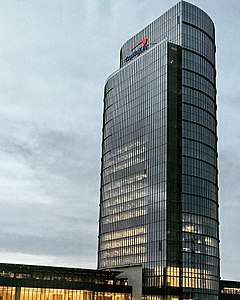
| Company | Industry | Headquarters | National rank |
|---|---|---|---|
| AES Corporation | Energy | Arlington, Virginia | 214 |
| Amazon | eCommerce | Arlington, Virginia | 2 |
| Booz Allen Hamilton | Consulting | McLean, Virginia | 482 |
| Capital One | Finance | McLean, Virginia | 101 |
| DXC Technology | Information technology | Tysons, Virginia | 374 |
| Freddie Mac | Finance | McLean, Virginia | 38 |
| General Dynamics | Defense | Falls Church, Virginia | 99 |
| Hilton Hotels Corporation | Hospitality | McLean, Virginia | 324 |
| Leidos | Defense | Reston, Virginia | 292 |
| Nestlé, USA | Confections | Arlington, Virginia | 76 |
| Northrop Grumman | Defense | Falls Church, Virginia | 118 |
| NVR, Inc. | Construction | Reston, Virginia | 444 |
| Company | Industry | Headquarters | National rank |
|---|---|---|---|
| Carahsoft | Defense | Reston, Virginia | 161 |
| Mars, Incorporated | Confections | McLean, Virginia | 7 |
Additionally, Verisign, the manager of the .com and .net top-level domains is based in the region.
Major companies formerly headquartered in the region include AOL, Mobil, Nextel/Sprint, PSINet, Sallie Mae, MCI Communications, Transurban, and UUNET.
Attractions
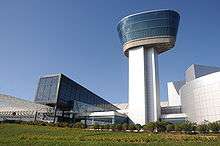
The region's large shopping malls, such as Potomac Mills and Tysons Corner Center, attract many visitors, as do the region's Civil War battlefields, which include the sites of both the First and Second Battle of Bull Run in Manassas and the Battle of Fredericksburg in Fredericksburg.[81] Old Town Alexandria is known for its historic churches, townhouses, restaurants, gift shops, artist studios, and cruise boats. The waterfront and outdoor recreational amenities such as biking and running trails (the Washington and Old Dominion Rail Trail leads all the way from Alexandria to the foothills of the Blue Ridge; the Mount Vernon Trail and trails along various stream beds are also popular), whitewater and sea kayaking, and rock climbing areas are focused along the Potomac River, but are also found at other locations in the Baltimore–Washington metropolitan area. Scenic Great Falls Park and historic Mount Vernon (which opened a new visitor center in 2006) are especially noteworthy. The Government Island park and quarry in Stafford County has views of the Potomac River, and Aquia Creek and also is where the building materials for the White House, and United States Capitol are from.[82] Also in Stafford County are historic places such as George Washington's boyhood home Ferry Farm[83], Civil War headquarters and plantation Chatham Manor[84], and artist Gari Melchers Home & Studio.[85]
Arlington National Cemetery is located in the area, as is the Steven F. Udvar-Hazy Center, an annex of the National Air and Space Museum that contains exhibits that cannot be housed at the main museum in Washington due to space constraints. Many concerts and other live shows are held at the Wolf Trap National Park for the Performing Arts, a setting which has attracted many famous productions over the years.[86]
Politics
Background
From the mid-1880s until the mid-1960s Virginia politics were dominated by Conservative Democrats. After World War I, under the leadership of Harry Flood Byrd, who became Governor of Virginia and later a U.S. senator, this group became known as the Byrd Organization. With a power base in a network of the constitutional officers of most of Virginia's counties, they controlled Virginia's state government. The Byrd Organization largely followed conservative and anti-debt principles espoused by Byrd, who had grown up in a rural setting during the fiscally stressed era following Reconstruction. Although a member of the Democratic Party and an initial supporter of President Franklin D. Roosevelt, Senator Byrd became a bitter opponent of the New Deal and related national policies, particularly those involving fiscal and social issues. He became Virginia's senior senator after the death of Senator Carter Glass of Lynchburg in 1946.
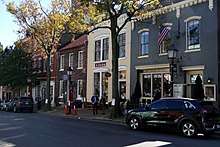
The period following World War II saw substantial growth of Virginia's suburban areas, notably in the regions of Northern Virginia, Richmond, and Hampton Roads. The population became more diverse. People of the emerging middle class were increasingly less willing to accept the rural focus of the General Assembly, nor Byrd's extreme positions on public debt and social issues. The latter was nowhere more graphically illustrated than with Byrd's violent opposition to racial integration of the state's public schools. His leadership in the failed policy of Massive Resistance to racial desegregation of the public schools and efforts to circumvent related rulings of the United States Supreme Court ultimately caused closure of some public schools in the state and alienated many middle class voters. The Byrd Organization had never been strong in Virginia's independent cities, and beginning in the 1960s, city and suburban factions increasingly supported efforts to make broad changes in Virginia. In this climate, the Republican Party of Virginia began making inroads.
Rulings by both state and federal courts that "Massive Resistance" was unconstitutional and a move to compliance with the court orders in early 1959 by Governor James Lindsay Almond Jr., and the General Assembly could be described as marking the Byrd Organization's "last stand", although the remnants of the Organization continued to wield power for a few years longer.[87]
When Senator Byrd resigned in 1965 he was replaced by his son Harry F. Byrd Jr. in the U.S. Senate. However, the heyday of the Byrd Organization was clearly in the past, ending 80 years of domination of Virginia politics by the Conservative Democrats with the election of a Republican governor, Linwood Holton, in 1969 for the first time in the 20th century, succeeding a longtime member of the Byrd Organization, Democrat Mills E. Godwin. To the amazement of many observers, Godwin changed parties and was elected again as governor in 1973, but as a Republican.
During the last quarter of the 20th century, Virginia's Republicans gained ground against the Democrats. Republican John Warner from Northern Virginia gained one of the seats in the U.S. Senate in 1978. After longtime state senator L. Douglas Wilder became governor in 1989, the first African American to become a governor in the United States, Republicans subsequently gained control of the Governor's mansion after the 1993 election. Republicans finally gained control of the General Assembly in the 1999 elections.
For a number of years, the recurring Republican theme was to reduce waste in state government and taxes. However, this seemed to reach a peak during the administration of Jim Gilmore, with a move to repeal an unpopular car tax accompanied by a failure to provide promised replacement funds to the counties, cities and towns. Subsequently, two Democrats were elected consecutively as governor, and control in the General Assembly shifted back to a more bipartisan balance of power. As governor, both Mark Warner and Tim Kaine were confronted with stabilizing state economics and dealing with a deteriorating transportation funding situation partially caused by the state's failure to index state fuel taxes to inflation, with a "cents per gallon" tax rate unchanged since the administration of Democratic Governor Gerald Baliles in 1986.
21st-century politics
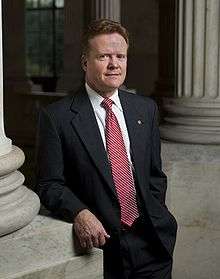

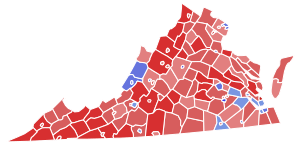
In the 21st century, Northern Virginia is becoming increasingly known for favoring candidates of the Democratic Party at both the state and national level. Fairfax County supported John Kerry in the 2004 presidential election, and also voted heavily for Barack Obama in the 2008 presidential election, the first time a Democratic candidate for President carried the Commonwealth of Virginia since Lyndon Johnson in 1964. The area also voted for Democrats Jim Webb in 2006 for U.S. Senate, Tim Kaine in 2005 for governor, and Mark Warner in 2001 for governor. In these three races for statewide office, the margins tallied in Northern Virginia provided the Democratic candidate with a winning margin of victory.
Democrat Jim Webb defeated incumbent Senator George Allen by the slim margin of 49.6 to 49.2 percent in 2006.[88] However, that margin increased to 58.1 to 40.7 percent in favor of the Democratic challenger in the counties and cities of Northern Virginia, whereas Webb ran behind Allen somewhat, 46.1 to 52.7 percent, in the remainder of the commonwealth. Webb carried Fairfax County, Prince William County, and Loudoun County, as well as the more urban areas of Arlington, Alexandria, and Falls Church. Allen's sole wins in Northern Virginia were the cities of Manassas and Manassas Park, winning the latter two only by the narrow margins of 3.54 and 2.38 percent, respectively.
In the 2004 presidential election, 53 percent of Northern Virginia voters voted for John Kerry, the Democratic candidate and 46 percent voted for George W. Bush, the Republican candidate. This contrasted with the rest of Virginia, which gave 43 percent to Kerry and 56 percent to Bush. Kerry also carried Fairfax County, the most populous county in Virginia, and Fairfax City, the first time those jurisdictions had voted Democratic since Johnson's national landslide in 1964. The strongest support in the area for the Democrats lies inside the Beltway, in Arlington, Alexandria, and parts of Fairfax County. The more distant areas (i.e., Loudoun County, Stafford County and Prince William County) historically have been more conservative; however, as they have increased in population, they have become more liberal. Both Mark Warner in 2001 and John Kerry in 2004 lost Loudoun and Prince William counties. Tim Kaine won Prince William County, and Loudoun counties in 2005. Tim Kaine won Stafford County in 2018.[89] In 2006 despite not polling as strongly as Mark Warner statewide, Democratic senate candidate Jim Webb won both Loudoun and Prince William counties. In 2005, 65 percent of the voters of Northern Virginia voted for Democrat Tim Kaine for governor over Jerry Kilgore, who received only 32 percent of the vote, easily 14 points lower than George W. Bush's showing only a year earlier.
The Democrats in Virginia also have made considerable gains in the Virginia House of Delegates which helped turn both chambers of the state legislature to the Democrats. Since 2015 Democrats have flipped disricts in the suburbs of Washington D.C in counties such as Stafford County, Prince William County, and Loudoun County. These flips have shown the changing demographics, and voting bloc in these counties and the expansion of suburbanization and Northern Virginia. For example, the 28th district a seat held by Republicans since 1984 in Stafford County and parts of Fredericksburg and seat of former Republican Virginia Speaker of the House William J. Howell. 10 years ago Republicans won the Virginia House of Delegates election with 74% of the vote in the district. In the 2019 election Joshua Cole a fierce Democrat and supporter of the Green New Deal fliped the district by 4 points. Another district the 2nd district that encompasses Prince William County and Stafford County was once a swing district held by both Republicans and Democrats. In 2017, Democrats flipped the district with 64% of the vote and was re-elected with 60% of the vote with Jennifer Caroll Foy a suppporter of the Equal Rights Amendment which she passed this year with the new Democratic trifecta in the state.
The 1st, 8th, the 10th, and the 11th congressional districts lie within Northern Virginia. The current congressman from the 1st district is Rob Wittman (R), from the 8th district is Don Beyer (D), the current congresswoman from the 10th district is Jennifer Wexton (D), and the current congressman from the 11th district is Gerry Connolly (D). Three of four districts voted for Jim Webb in the 2006 Senate election.
In the 2005 gubernatorial election, the entire region continued to move away from the Republicans. Fairfax County, Arlington County, the cities of Alexandria, Fairfax City, and Falls Church, and for the first time, Loudoun County and Prince William County, went to Tim Kaine, the Democratic candidate. The area continued to be more Democratic the closer it was to Washington, D.C., but Richmond resident Kaine was able to accomplish what Northern Virginian Mark Warner had been unable to do just four years earlier in 2001: carry Loudoun County and Prince William County (as well as win over 60 percent of the vote in Fairfax County).
In 2006 Democrat Mark Herring swept every precinct in the 33rd state Senate District on January 31, en route to beating Republican Loudoun County Supervisor Mick Staton by a margin of 62 to 38 percent, providing evidence for the claim that Loudoun is transforming into a liberal county. The district sits primarily in Loudoun County but also includes nine precincts in western Fairfax County: Floris, Fox Mill, Frying Pan, McNair, Franklin, Kinross, Navy, Lees Corner East, and Lees Corner West.
In 2008 economist Nancy Pfotenhauer, a spokesperson and adviser for the John McCain presidential campaign, created controversy by referring to the areas of Virginia not included in Northern Virginia as "real Virginia", picking up on a Republican talking point that Sarah Palin promoted; namely that red states are the "real America" and more "pro-America".[90] Joe McCain, brother of John McCain, also called Arlington and Alexandria in Northern Virginia "communist country".[91]
In the 2008 presidential election, the majority of Northern Virginia voters voted for Democratic presidential candidate Barack Obama. Over 70 percent of registered voters in Arlington, Alexandria and Falls Church voted for Obama.[92] Fairfax County, Loudoun County, Manassas and Prince William County also went to Obama, with Obama receiving 60 percent of the vote in Fairfax County compared to Republican candidate John McCain's 39 percent.[92] Obama's win in Fairfax County, the most populous county in the state, marks the second time a Democrat has carried that county since the 1964 breakdown of Democratic predominance in the South (the other being the 2004 presidential elections when the county went to John Kerry). Obama's victory in Northern Virginia continues the trend of Northern Virginia favoring Democrats over Republicans.
In the 2009 gubernatorial election, though Arlington, Alexandria, and Falls Church would back Democratic state Senator Creigh Deeds in his unsuccessful run for governor, Republican former state Attorney General, and future Governor, Bob McDonnell, who overwhelmingly defeated Deeds 59 to 41 percent across the state as a whole, won Fairfax County, Loudoun County, Stafford County, Manassas, and Prince William County. However, a January 2010 special state Senate election in the Fairfax county based 37th State Senatorial district, which was held following Ken Cuccinelli's (R) resignation from the Senate of Virginia upon his election as state Attorney General two months earlier, was won by then-Delegate David W. Marsden (D). Marsden's victory would suggest that despite McDonnell's performance in northern Virginia during the 2009 gubernatorial election, the Democratic trend in the region has not been reversed.[93]
A 2011 Washington Post poll found that 47 percent of Virginians favored the legalization of same-sex marriage, while 43 percent opposed it and 10 percent had no opinion. It found 55 percent favored allowing same-sex couples to adopt children, while 35 percent opposed that and 10 percent had no opinion.[94] The same poll found that 64 percent of residents Arlington, Alexandria, Fairfax, Fairfax County support same-sex marriage, 63 percent of residents of Loudoun, Prince William, Manassas, Manassas Park, Stafford, Fauquier, Culpeper, Madison, Rappamannock, Warrenton, Clarke County, Frederick, and Winchester support same-sex marriage, while only 42 percent of the rest of Virginia supports same-sex marriage.[95]
Arlington, Clarke, Culpeper, Fairfax, Fauquier, Frederick, Loudoun, Prince William, Rappahannock, Spotsylvania, Stafford, and Warren counties, as well as Alexandria, Falls Church, Fairfax, Fredericksburg, Manassas, Manassas Park, and Winchester cities, form Northern Virginia's contribution to the Washington metropolitan area; Hillary Clinton received 849,758 votes compared to Donald Trump's 503,120 votes in the twelve-county and seven-city region, a 63–37 percent split in the 2016 presidential election. Despite the 26 percent margin of victory for Clinton, seven counties voted for Trump. This compares to Clinton's 825,974 votes to Trump's 236,827 votes (78 to 22 percent) in Calvert, Charles, Frederick, Montgomery, and Prince George's counties in Maryland as well as her 282,830 votes to his 12,723 votes (96 to 4 percent) in Washington, D.C. Among the aforementioned counties in Maryland, Trump carried two of them. The entire Washington metropolitan area – all seventeen counties and seven cities in Maryland and Virginia, plus the District of Columbia – voted 1,958,562 ballots to 752,670 ballots (72 to 28 percent) for Clinton and Trump, respectively. Compared to the entire state, Northern Virginia's twelve counties and seven cities represent 36 percent of the total electorate.[96]
Culture
Due to the proximity to the capital, many Northern Virginians go to Washington, D.C., for cultural outings and nightlife. The Kennedy Center in Washington is a popular place for performances, as is Wolf Trap National Park for the Performing Arts near Vienna. Jiffy Lube Live (near Manassas), EagleBank Arena at George Mason University in Fairfax, and Capital One Arena in Washington serve as popular concert venues, and Capital One Arena also serves as the home of sporting events. Smithsonian museums also serve as local cultural institutions with easy proximity to Northern Virginia, and the Udvar-Hazy Center of the National Air and Space Museum in Chantilly is popular as well.
.jpg)
Tysons Corner Center ("Tysons I") is one of the largest malls in the country and is a hub for shopping in area. Tysons Galleria ("Tysons II"), its counterpart across Route 123, carries more high-end stores. Tysons itself is the 12th largest business district in the United States.[97] Other malls include Springfield Mall, Fair Oaks Mall, Manassas Mall, Spotsylvania Towne Centre which has a mall and a mixed-use retail and commercial area, and The Fashion Centre at Pentagon City. Dulles Town Center is the region's newest mall, serving the eastern Loudoun County area. Reston Town Center is a high-density mixed-use retail, commercial, and residential development located just off the 267 Toll Road in Reston. Potomac Mills, located in Prince William County, is the largest outlet mall in the region. The town of Leesburg in Loudoun County contains the Leesburg Corner Premium Outlets outlet mall.
Since the mid-1990s, Loudoun County and has been known as America's fastest-growing county, having grown by almost 50 percent from 2000 though 2005. Stafford County is also one of the fastest-growing counties in the country. Stafford County according to a Census Bureau report was the sixth highest-income county.[98] Since the 2000 census, both Loudoun and Fairfax counties are the top large U.S. counties by median household income. Loudoun County has branches of at least five higher education institutions.
Recreation
Northern Virginia is home to many activities for families and individuals, including biking/walking trails, sports leagues, recreation facilities, museums, historic homes, and parks.
It is home to the Northern Virginia Swim League, which comprises 102 community pools, and NVSL-Dive, which is composed of 47 teams in Fairfax and Arlington counties. The swim and dive teams compete over the course of 5–6 weeks from the end of June through the first weekend in August.
The National Capital Area Council operates in the D.C Area. It serves localities in the Washington D.C Metropolitan Area. In Northern Virginia, it has chapters and divisions that serve, Fairfax County, Loudoun County, Prince William County, Stafford County, Arlington County, the City of Alexandria, and the City of Fairfax. It also serves Caroline County, the City of Fredericksburg, and Spotsylvania County.
The National Capital Soccer League serves soccer leagues and associations in the Washington D.C Metropolitan Area. It includes Northern Virginia soccer associations in Fairfax County, Loudoun County, Prince William County, Stafford County, Arlington County, the City of Fredericksburg, the City of Alexandria, the City of Fairfax, and one soccer association in Culpeper County, Winchester, and Warrenton.
Secession
Former Republican delegate Jeannemarie Devolites Davis expressed a common sentiment when she said "The formula for funding school construction in Northern Virginia requires that we pay 500 percent more than the actual cost of a project. We have to pay 500 percent because we give 400 percent away to the rest of the state." The state government's funding level for transportation projects in Northern Virginia is a perennial issue that often causes consternation from the region's politicians and citizens.[99]
Many people consider the idea of secession a rhetorical one used to express frustration with the treatment of Northern Virginia by the state government as well as the opposing political sentiments between it and the rest of Virginia. Critics often point out that all states include regions of varying income and political discrepancies within their borders. Nevertheless, the Northern Virginia suburbs of Washington, D.C., are often seen as an extension of the more urbanized Mid-Atlantic, north-east, and the Boston-Washington corridor, even though Virginia as a whole is considered a Southern state. This perception is especially fueled by the region's closeness to Washington, D.C., large numbers of Northern transplants, and the prevalence of both new immigrant communities and growing ethnic diversity.
A tongue in cheek editorial in a Fredericksburg weekly paper suggested the rest of Virginia would like to separate Northern Virginia from the remainder of the commonwealth.[100] Nevertheless, there is no serious secessionist movement.[101]
Transportation

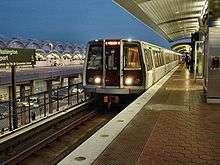
The area has two major airports, Ronald Reagan Washington National Airport and Washington Dulles International Airport. While flights from the older National Airport (a hub for American Airlines) are restricted for distance, frequency, and flight paths due to the proximity to federal facilities, Dulles is the region's second busiest airport[102] in both passenger loadings and aircraft movements, and the sixteenth-busiest airport[103] in the United States by takeoffs and landings in 2007. Dulles is the region's primary international gateway, serves as a hub for United Airlines, and has recently improved its low-cost carrier offerings with the addition of multiple flights by Southwest and JetBlue.
Commuters are served by the Washington Metro subway and the Virginia Railway Express, a commuter railroad. Metro is the second-busiest subway system in the nation; only New York City's subway system carries more passengers.[104] A planned expansion project will extend the system past Dulles Airport into Loudoun County. The VRE has two lines adjacent to I-66 and I-95 starting in Union Station and extending to Manassas and Spotsylvania respectively.[105] VRE service is significantly more limited, but nevertheless saw over a year of continuous ridership increase from 2007 into 2008.[106] Bus service is provided by WMATA's Metrobus and several local jurisdictions.
The Washington metropolitan area has the worst traffic in the nation,[107] and Northern Virginia is home to six of the ten worst bottlenecks in the area.[108] To alleviate gridlock, local governments encourage using Metrorail, HOV, carpooling, slugging, and other forms of mass transportation. Major limited- or partially limited-access highways include Interstates 495 (the Capital Beltway), 95, 395, and 66, the Fairfax County Parkway and adjoining Franconia–Springfield Parkway, the George Washington Memorial Parkway, and the Dulles Toll Road. High-occupancy vehicle (HOV) lanes are used for commuters and buses on I-66, I-95/395, and the Dulles Toll Road. A study done by INRIX Roadway Analytics ranked Southbond I-95 from Washington D.C to the southern tip of Stafford County the worst single traffic hotspot in the nation. It also ranked Northbond I-95 from Spotsylvania County to the northern tip of Stafford County the seventh worst traffic hotspot in the nation.[109] Northern Virginia is also home to the Express Lanes. These express lanes are where a car has a transbonder and is charged for riding a distance on the express lanes. They are currently being built on I-66, and are currently available on I-395, I-495 from the Springfield Interchange to Tysons Corner but are being extended to the Maryland-Virginia border, and I-95 from the end of I-395(Springfield Interchange) to central Stafford County and are being extended to Fredericksburg.
Two major regional bottlenecks, the Springfield Interchange and Woodrow Wilson Bridge, were massively reconstructed with completion in 2007 and 2008. Generally, Potomac River crossings remain major choke points; proposals to add crossings (such as near Leesburg or Quantico as part of a long-proposed Outer Beltway) are opposed by Virginia communities near the suggested bridge sites, and by Marylanders who fear that new bridges would bring new housing development to green space in that state such as Poolesville. Because of Northern Virginia's high housing costs, tens of thousands of employees there choose more affordable housing far away in outer Virginia exurban counties, or in Prince George's County and Southern Maryland, thus creating tremendous traffic congestion on the Potomac bridges. This situation is much like metropolitan areas of California. Furthermore, Fairfax County localities such as Great Falls, Dranesville, and Clifton impose low-density, large-acreage residential zoning, which forces developers to leapfrog into Loudoun and Prince William counties to build housing, thus increasing commuters' driving distances. In recent years, developers have continued to develop in Loudoun County but have filled Prince William County. Therefore many developers have been moving south to Stafford County where local government has been more reluctant to developments.
Education
Fairfax County's public school system includes the Thomas Jefferson High School for Science and Technology, an award-winning magnet school. Nineteen of the region's schools appear in the top 200 of Newsweek's 'America's Top Public High Schools', and Thomas Jefferson is ranked number one.[110] In comparison, Washington, D.C., Maryland, and the rest of Virginia have 10 schools between them in the top 200.[110]
Although Northern Virginia contains a large portion of the commonwealth's population, there are only a handful of colleges and universities in the region. The largest and most well-known is George Mason University in Fairfax, the largest university in Virginia.
Other higher education institutions include Northern Virginia Community College (colloquially known as NOVA) in Annandale (with several branch campuses throughout Northern Virginia), the University of Mary Washington in Fredericksburg, Patrick Henry College in western Loudoun County, and Marymount University in north Arlington. In addition, the University of Virginia and Virginia Tech maintain a Center in Falls Church, and George Washington University has a campus in Loudoun County. Virginia Commonwealth University Health Systems has a satellite campus in Fairfax at the INOVA healthcare system.
References
- 13 counties and 7 independent cities within the Washington MSA or Washington-Baltimore CSA
- "Annual Estimates of the Resident Population: April 1, 2010 to July 1, 2017, U.S. Census Bureau, Population Division". Archived from the original on September 25, 2017. Retrieved March 29, 2020.
- Demographics & Workforce Data and Research for Virginia
- "American FactFinder". Archived from the original on June 25, 2009. Retrieved March 26, 2008.
- Gregg, Aaron. "D.C. suburbs becoming one of the country's fastest-growing employment hubs". The Washington Post.
- Matt Woolsey, America's Richest Counties, Forbes.com, 01.22.08, 6:00 PM ET Forbes.com website. Retrieved on 2008-02-08.
- USGS Correspondence Handbook
- Johnston, Wilbur S. (2006). "The Northern Neck in Colonial Context". Winchester-Frederick County Historical Society, Winchester Printers, Inc. Cite journal requires
|journal=(help) - The Official Guide of Virginia's Northern Neck (2007), Northern Neck Tourism Council
- https://www.census.gov/programs-surveys/metro-micro/about/omb-bulletins.html | OMB Bulletin No. 18-04, Revised Delineations of Metropolitan Statistical Areas, Micropolitan Statistical Areas, and Combined Statistical Areas, and Guidance on Uses of the Delineations of These Areas
- "Thomas, Lord Fairfax". The Fort Edwards WebPage. Retrieved April 18, 2010.
- Grant of the Office of Lieutenant and Governor-General, June 21, 1675, Calendar of State Papers, Colonial Series, Great Britain Public Record Office, Her Majesty's Stationery Office, 1896
- Letter from Nicholas Spencer to Secretary Thomas Coventry, August 20, 1680, reporting news of Culpeper's departure from Virginia, Calendar of State Papers, Colonial Series, Great Britain Public Record Office, Whitehall, Her Majesty's Stationery Office, London, 1890
- History of the Colony and Ancient Dominion of Virginia, Charles Campbell, J. P. Lippincott & Co., Philadelphia, 1860
- Letters of William Fitzhugh, The Virginia Magazine of History and Biography, Vol. II, The Virginia Historical Society, Richmond, 1895
- "The Fairfax Grant". Virginia Places. Retrieved April 18, 2010.
- Grymes, Charles A. "The Fairfax Grant". Retrieved September 7, 2008.
- "Lord Fairfax Land Records". Handley Regional Library: Winchester-Frederick County Historical Society. Archived from the original on October 1, 2006. Retrieved April 18, 2010.
- "A Guide to the Lord Thomas Fairfax land grant to Robert Carter". Colonial Williamsburg Foundation's John D. Rockefeller Jr. Library. 2008. Retrieved April 18, 2010.
- "Phillips v. Payne, 92 U.S. 130". FindLaw. 1875. Retrieved March 7, 2017.
- citation needed
- "Virginia Convention of 1861 - Civil War Collections - University of Richmond".
- "War on Terror a Boon For Virginia". Archived from the original on April 6, 2008. Retrieved April 9, 2008.
- Northern Virginia
- Bamford, James (2009). The Shadow Factory: The Ultra-secret NSA from 9/11 to the Eavesdropping on America. Random House. p. 187. ISBN 9780307279392. Retrieved February 27, 2014.
- "The Internet's Busiest Intersection". Data Center Knowledge. June 9, 2009.
- O'Connell, Jonathan. "Data centers boom in Loudoun County, but jobs are not following". The Washington Post.
- "Northern Virginia Regional Commission - Website | Official Website". www.novaregion.org. Retrieved April 1, 2020.
- "Member Governments | Northern Virginia Regional Commission - Website". www.novaregion.org. Retrieved April 1, 2020.
- "About VAPDC". Vapdc 080318. Retrieved April 1, 2020.
- MWCOG.org – About Us
- MWCOG.org – Transportation – TPB
- Resident Population Data. "Resident Population Data – 2010 Census". 2010.census.gov. Archived from the original on October 23, 2012. Retrieved December 22, 2016.
- "Annual Estimates of the Resident Population: April 1, 2010 to July 1, 2019" (Excel). U.S. Census Bureau, Population Division. Retrieved March 16, 2019.
- https://demographics.coopercenter.org/virginia-regions | University of Virginia, Weldon Cooper Center for Public Service
- http://statchatva.org/files/2015/11/Commuting-1024x1024.jpg
- Fairfax County, Virginia detailed profile – houses, real estate, agriculture, wages, work, ancestries, and more
- Prince William County, Virginia detailed profile – houses, real estate, agriculture, wages, work, ancestries, and more
- Loudoun County, Virginia detailed profile – houses, real estate, agriculture, wages, work, ancestries, and more
- Arlington County, Virginia detailed profile – houses, real estate, agriculture, wages, work, ancestries, and more
- "ACS: Ranking Table – Percent of People 25 Years and Over Who Have Completed a Bachelor's Degree". United States Census Bureau. Archived from the original on October 13, 2004. Retrieved August 27, 2008.
- "Seattle city, Washington – Educational Attainment". Archived from the original on February 12, 2020. Retrieved November 12, 2008.
- "Arlington County, Virginia – Educational Attainment". Archived from the original on February 12, 2020. Retrieved November 12, 2008.
- https://www.pbs.org/newshour/nation/black-households-make-money-white-ones-seven-counties
- Income, Earnings, and Poverty Data From the 2007 American Community Survey
- Cost of Living Can Significantly Affect "Real" Median Household Income Archived July 2, 2008, at the Wayback Machine
- Loudoun tops the nation in 25-to-34-year-olds with hefty incomes
- Nielsen: The Young and Moneyed Dwell in D.C.
- Rems, Janet (March 3, 2011). "City planners use Reston as a model". The Washington Post. Retrieved March 4, 2011.
- Potts, M. (1989) "The Swanky Side of Fairfax Square" The Washington Post
- "Tysons Galleria" (PDF). Archived from the original (PDF) on March 20, 2009. Retrieved January 2, 2009.
- Sotheby's International Realty opens shop in Northern Virginia
- Gangs flee N.Va.for havens in Md., D.C., report says
- Crime Drops for Fourth Straight Year in Fairfax County
- 2 Counties: A Dangerous Difference; While Montgomery's Crime Rate Has Risen, Fairfax's Is Down Series: VULNERABLE SUBURBS: THE GROWTH OF VIOLENT CRIME Series Number: 2/2
- Fairfax County Board of Supervisors Election
- Gangs in Northern Virginia increasingly selling children for sex
- High-Rises Approved That Would Dwarf D.C.
- List of tallest buildings in DC, MD, VA, WV
- Virginia's new governor keeps focus on jobs and technology
- The CoStar Office Market Watch
- Unemployment state by state
- Clabaugh, Jeff (October 26, 2008). "Northern Virginia still creating jobs". Washington Business Journal. Retrieved November 14, 2008.
- McCaffrey, Scott (October 26, 2008). "Arlington Jobs Picture Still Best in Virginia". Sun Gazette Newspapers. Retrieved November 14, 2008.
- Unemployment Dips Slightly Across Arlington
- Koelemay, Doug. "Competing for the Creative Class". Bacon's Rebellion.
- "Amazon reveals first rendering of its HQ2 in Arlington, Virginia". The Architect's Newspaper. May 17, 2019.
- "Amazon Approaches 1 Gigawatt of Cloud Capacity in Virginia". Data Center Frontier. January 16, 2017.
- "Northern Virginia – world's first data centre market to reach one gigawatt of capacity". Data Economy. April 26, 2019.
- "Northern Virginia: America's Largest Data Center Market". Data Center Frontier. March 16, 2017.
- After dramatic growth, Ashburn expects even more data centers
- Garber, Kent (March 24, 2009). "The Internet's Hidden Energy Hogs: Data Servers". U.S. News & World Report. Retrieved March 25, 2007.
- Estimate: Amazon Cloud Backed by 450,000 Servers
- Amazon Adding Cloud Capacity in Northern Virginia
- "Best East Coast Cities for Defense Jobs". Archived from the original on January 24, 2009. Retrieved January 14, 2009.
- Industry dynamics in the Washington, DC, area: has a second job core emerged?
- "Positive review for Capital One's massive headquarters in Tysons". American City Business Journals.
- "Fortune 500". Fortune.com. Retrieved December 4, 2018.
- "America's Largest Private Companies". Forbes. Retrieved June 24, 2017.
- Battle of Fredericksburg
- Public Quarry at Government Island
- Ferry Farm
- Chatham Manor
- Gari Melchers Home & Studio
- Cooper, Rachel. "Top 10 Northern Virginia Attractions". About.com. Retrieved April 12, 2010.
- Glasrud, Bruce; Ely, James W. (May 1977). "The Crisis of Conservative Virginia: The Byrd Organization and the Politics of Massive Resistance (book review)". The Journal of Southern History. The Journal of Southern History, Vol. 43, No. 2. 43 (2): 324–325. doi:10.2307/2207385. JSTOR 2207385.
- "General Election- November 7, 2006". Archived from the original on November 21, 2006. Retrieved November 16, 2006.
- https://www.fredericksburg.com/news/local/election-results-in-fredericksburg-region-reflect-suburban-rural-divide/article_e15de970-eb88-56b2-8d7f-1a93fe20ee06.html
- Tapper, Jake (October 18, 2008). "McCain Adviser Says Northern Virginia Not "Real" Virginia". Archived from the original on October 26, 2008. Retrieved October 28, 2008.
- Tapper, Jake (October 5, 2008). "Joe McCain Makes Bad Joke". Retrieved December 6, 2008.
- "County Results - Election Center 2008 - Elections & Politics from CNN.com". CNN. Retrieved May 20, 2010.
- "Virginia Special Election Sends a Message to GOP". The Economist Group. January 13, 2010. Archived from the original on January 16, 2010. Retrieved February 13, 2010.
- The Washington Post: "Washington Post poll finds Virginians are split on gay marriage; support gay couple adoptions", May 10, 2011, accessed May 10, 2011
- Virginia politics, Northern Virginia style
- Leip, David. "General Election Results – Virginia". United States Election Atlas. Retrieved July 15, 2018.
- Tysons Regional Chamber of Commerce, "Our Community"
- Stafford County, Virginia
- Lindsay, Drew (November 1, 2008). "Will Northern Virginia Become the 51st State?". The Washingtonian. Retrieved April 18, 2010.
- Johnson, Jonnie (March 3, 2002). "A solution to Northern Virginia's many problems: Forced secession". Fredericksburg.com. Retrieved April 18, 2010.
- Wiencek, Drew (June 3, 2003). "Why Isn't There An East Virginia". Virginia Places. Retrieved April 26, 2010.
- "Archived copy". Archived from the original on August 3, 2017. Retrieved July 11, 2017.CS1 maint: archived copy as title (link) CS1 maint: BOT: original-url status unknown (link)
- "Archived copy". Archived from the original on June 5, 2008. Retrieved 2009-01-06.CS1 maint: archived copy as title (link)
- Dawson, Christie (December 4, 2008). "Heavy Rail Rapid Transit Ridership Report, Third Quarter 2008" (PDF). American Public Transportation Association. Archived from the original (PDF) on February 6, 2009. Retrieved January 27, 2009.
- Virginia Railway Express
- "Fredericksburg.com – VRE riders breaking records – page 1 FLS". Archived from the original on January 9, 2009. Retrieved January 6, 2009.
- Trull, Armando (September 27, 2011). "D.C. Area Has Worst Traffic in U.S". Archived from the original on December 1, 2011. Retrieved December 3, 2011.
- Essley, Liz (December 2, 2011). "Top 10: The worst traffic bottlenecks in the Washington area". Retrieved December 3, 2011.
- https://www.fredericksburg.com/news/transportation/d-c--to-stafford-stretch-of-i-95-tabbed-worst-traffic-hotspot-in-u/article_b094fa03-527a-5826-bba5-de7e24810b69.html
- America's Top Public High Schools
Further reading
- D.C. Dotcom Time (2000)
- Where is Northern Virginia? Bacon's Rebellion (2003)
- So Close, Yet So Far Apart The Washington Post (2006)
- The Federal Job Machine Time (2007)
- Will Northern Virginia Become the 51st State? The Washingtonian (2008)
- The Corporate Intelligence Community: A Photo Exclusive Tim Shorrock (2010)
- The Washington Post (2010)
External links
| Wikivoyage has a travel guide for Northern Virginia. |
